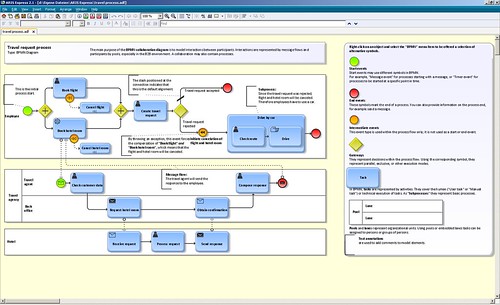 Our latest free Knowledge Management newsletter was released yesterday, the theme of this issue being how to embed Knowledge Management into the "day job".
Our latest free Knowledge Management newsletter was released yesterday, the theme of this issue being how to embed Knowledge Management into the "day job".One way to embed Knowledge Management is to build it into business process. I thought I would expand a little on how to do this.
Most large organisations have pretty well-defined business processes. These may include
- A Marketing process
- A Sales process
- A New Product Development process
- A Manufacturing process
- A packaging/distribution process
- A Project management process
- A Service-call resolution process
and so on. These processes consist of a series of steps, often shown diagrammatically as a flow chart, like the example shown.
Embedding KM into these processes means putting Knowledge Management-specific steps into that flowchart.
You can start, by identifying where, within the business process, there is the greatest need for the team to acquire knowledge, and adding a "Knowledge Acquisition" step, such as Peer Assist, Lessons Review, Knowledge Site Visit, Collaborative work session, or a Knowledge Management Plan. There may be several such steps needed within the business process.
You can look at where, within the business process, there is the greatest need for the team to create new knowledge, and add a "Knowledge Creation" step, such as Deep Dive, Think Tank, or Business Driven Action Learning.
You can look at where, within the business process, there is the greatest need for the team to create new knowledge, and add a "Knowledge Creation" step, such as Deep Dive, Think Tank, or Business Driven Action Learning.
Then you can look at where, within the business process, there is the greatest need for the team to discuss and identify learning. These will be steps which follow points where the greatest knowledge has been created, or the greatest learning acquired, and where you need to add a "Knowledge Capture" step. Some of these will capture knowledge for re-use by the same team, and may include small scale After Action Reviews. Some will capture knowledge and lessons for other teams, and may include Retrospect. Some may include hand-over of knowledge to later stages in the project or product life-cycle, and may include Baton Passing or Knowledge handover. There may be several such steps needed within the business process.
That is your starting point - looking at the flow of knowledge into and out of the process. You may eventually add other steps where needed.
The important thing is to 1) find knowledge management processes which work in your context, and 2) make sure those KM process appear, as little boxes, within the business process flow chart. That way, they will be applied.




No comments:
Post a Comment